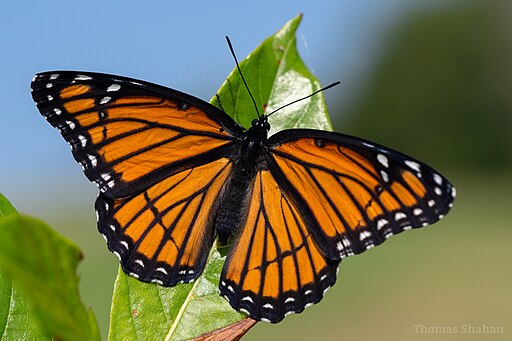Monarch butterflies are known for their vibrant orange coloration and black veins on their wings. They also have a larger size compared to viceroy butterflies. Monarchs are famous for their incredible long-distance migrations spanning continents, with some individuals traveling up to 3,000 miles in a single journey.
Viceroy butterflies display a more subdued appearance with brownish-orange wings featuring dark lines across them. While they may resemble monarchs at first sight, one distinguishing characteristic is the presence of an additional black line on the hindwings near the margin. Viceroys do not undertake extensive migrations like monarchs but instead tend to stay within localized areas.
Monarch Butterflies

Monarch butterflies, with their vibrant orange and black wings, are a sight to behold. These regal creatures have captured the hearts of butterfly enthusiasts around the world. One of the most distinguishing features of monarch butterflies is their incredible size – they boast an impressive wingspan ranging between 3.7 to 4 inches.
But it’s not just their size that makes them stand out; monarch butterflies are also known for their fascinating life cycle. Starting as tiny eggs laid on milkweed plants, these eggs hatch into caterpillars that voraciously feed on milkweed leaves before forming chrysalises. Within these chrysalises, a miraculous transformation takes place, turning caterpillars into stunning adult butterflies.
However, what truly sets monarch butterflies apart is their awe-inspiring migration journey. Every year, millions of monarchs embark on a remarkable round-trip spanning thousands of miles from Canada and the United States to Mexico’s forests. This epic migration is nothing short of a marvel in the natural world.
Beyond their physical beauty and migratory prowess, monarch butterflies serve as an important symbol for conservation efforts worldwide. Their population has faced significant declines due to habitat loss and climate change impacts on both breeding grounds and wintering sites.
Viceroy Butterflies

Viceroy butterflies may appear similar to monarchs at first glance, but upon closer inspection, their unique characteristics become apparent. These beautiful insects can be found throughout North America and are often mistaken for monarchs due to their striking orange and black coloration.
In terms of size, viceroy butterflies have an average wingspan ranging from 2.5 to 3.5 inches. Their wing shape is also different – while both species have broad wings, viceroy butterflies possess more pointed tips compared to the rounded edges seen in monarchs.
Another interesting aspect about viceroy butterflies is their behavior when it comes to migration patterns. Unlike monarchs that undertake long-distance migrations spanning thousands of miles each year, viceroy butterflies tend to stay in one region or area throughout their lifespan.
Monarch butterflies Vs. Viceroy butterflies – Key differences
| Aspect | Monarch Butterfly | Viceroy Butterfly |
|---|---|---|
| Coloration | Bright orange wings with black veins and white spots. | Resembles the monarch with orange wings but has a black line across the hindwings. |
| Mimicry | Warning coloration; toxic due to consuming milkweed. | Mimicry; non-toxic but resembles the toxic monarch, gaining protection. |
| Size | Larger size, with a wingspan ranging from 3.7 to 4.1 inches. | Slightly smaller, with a wingspan ranging from 2.75 to 3.25 inches. |
| Range | Widespread in North and South America, with migration patterns. | Found in North America, overlapping with the monarch's range. |
| Migration | Known for long-distance migration, particularly in North America. | No long-distance migration; typically a sedentary species. |
| Habitat | Various habitats, including gardens, meadows, and open areas. | Similar habitats but often found near wetlands or water sources. |
| Caterpillar Host Plants | Feeds exclusively on milkweed plants. | Caterpillars feed on willow and poplar leaves. |
| Flight Characteristics | Slow and steady flight with gliding patterns. | Swift and erratic flight with rapid wing beats. |
| Antenna | Monarch butterflies have slightly thicker antennae. | Viceroy butterflies have thinner and more curved antennae. |
Monarch butterflies Vs. Viceroy butterflies – Physical Characteristics
Monarch Butterfly:
- Coloration: Bright orange wings with black veins and white spots.
- Size: Larger size, with a wingspan ranging from 3.7 to 4.1 inches.
- Mimicry: Warning coloration, as they are toxic due to consuming milkweed.
- Migration: Known for long-distance migration, especially in North America.
- Habitat: Found in various habitats, including gardens, meadows, and open areas.
- Caterpillar Host Plants: Feeds exclusively on milkweed plants.
- Flight Characteristics: Slow and steady flight with gliding patterns.
- Antenna: Slightly thicker antennae.
Viceroy Butterfly:
- Coloration: Resembles the monarch with orange wings but has a black line across the hindwings.
- Size: Slightly smaller than the monarch, with a wingspan ranging from 2.75 to 3.25 inches.
- Mimicry: Mimics the monarch for protection but is non-toxic.
- Migration: No long-distance migration; typically a sedentary species.
- Habitat: Similar habitats to the monarch, often found near wetlands or water sources.
- Caterpillar Host Plants: Caterpillars feed on willow and poplar leaves.
- Flight Characteristics: Swift and erratic flight with rapid wing beats.
- Antenna: Thinner and more curved antennae.
Monarch butterflies Vs. Viceroy butterflies – Differences in Migration Patterns
Monarch Butterflies:
- Long-Distance Migration: Monarchs are famous for their remarkable long-distance migration. They travel thousands of miles from North America to central Mexico for the winter.
- Generational Migration: The migration is multigenerational. The butterflies that arrive in Mexico are not the same individuals that started the journey; instead, it involves multiple generations.
- Wintering in Clusters: Monarchs cluster in large numbers in oyamel fir trees in the mountains of central Mexico during the winter months.
- Spring Migration Back: In spring, they begin the journey back north, laying eggs along the way. The new generation continues the migration.
Viceroy Butterflies:
- Limited Long-Distance Migration: Viceroy butterflies do not undertake long-distance migration like monarchs.
- Sedentary Nature: Viceroys are generally more sedentary and do not engage in the extensive migratory patterns observed in monarchs.
- Local Movements: While not true migration, Viceroys may exhibit local movements in response to seasonal changes or food availability.
Image Credits
Featured Image By – © Derek Ramsey / derekramsey.com
Image 1 By – © Derek Ramsey / derekramsey.com
Image 2 By – Thomas Shahan 3, CC BY 2.0, via Wikimedia Commons









